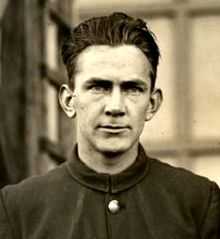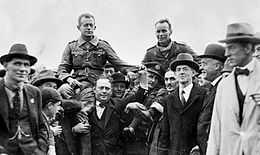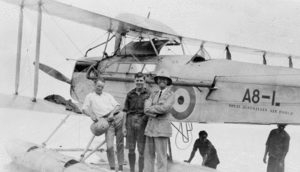Ivor McIntyre
| Ivor Ewing McIntyre | |
|---|---|
 Ivor McIntyre | |
| Born |
6 October 1899 Herne Bay, Kent, England |
| Died | 12 March 1928 (aged 28) |
| Allegiance |
|
| Service/branch |
|
| Years of service | 1917–1928 |
| Rank | Flight Lieutenant |
| Battles/wars | World War I |
| Awards |
Commander of the Order of the British Empire Air Force Cross & Bar |
Ivor Ewing McIntyre CBE, AFC & Bar (6 October 1899 – 12 March 1928) was a pilot in the Royal Australian Air Force (RAAF). He came to national attention in 1924 when he and Wing Commander (later Air Vice Marshal) Stanley Goble became the first men to circumnavigate Australia by air. Two years later McIntyre piloted the first international flight undertaken by an RAAF plane and crew, under the command of Group Captain (later Air Marshal Sir) Richard Williams. The English-born McIntyre had served with the Royal Naval Air Service and Royal Air Force in World War I, before joining the RAAF. He died in an aircraft crash in 1928.
Early career
Born in Kent, England, Ivor McIntyre joined the Royal Naval Air Service (RNAS) in 1917, seeing action in World War I as a Flight Sub-Lieutenant.[1] He transferred to the Royal Air Force (RAF) on its creation as an independent armed service, and was a Lieutenant when awarded the Air Force Cross in the 1919 New Year Honours.[2] McIntyre was granted a Short Service commission in the RAF as a Flying Officer on 12 December 1919.[3] He joined the Royal Australian Air Force (RAAF) in the early 1920s.[1]
Pioneering flights
Circumnavigation of Australia

In 1924, McIntyre and Wing Commander Stanley (Jimmy) Goble, another World War I veteran of the RNAS, became the first men to circumnavigate Australia by air. McIntyre was lead pilot while Goble, who was Chief of the Air Staff at the time, acted as commander and navigator. The pair took off from Point Cook, Victoria, on 6 April 1924 in a single-engined Fairey IIID floatplane. They flew anticlockwise along the eastern coast to Thursday Island, crossed the Gulf of Carpentaria to Darwin, then continued along the Western Australian and South Australian coasts. Along the way they faced adverse weather, fatigue and illness, and had to deal with engine problems and fuel leaks.[1][4]
McIntyre and Goble returned to Victoria after covering 8,450 miles (13,600 km) in 44 days. As they flew over Point Cook, 12 RAAF aircraft took off to escort them to their landing place at St Kilda Beach, where a crowd of 10,000 people was waiting to welcome them.[4] Prime Minister Stanley Bruce called the journey "one of the most wonderful accomplishments in the history of aviation"; his government presented McIntyre with a gift of ₤250, while mission commander Goble received ₤500.[1] The British Royal Aero Club awarded the duo the annual Britannia Trophy, and they were appointed Commanders of the Order of the British Empire (CBE) in the King's Birthday Honours.[4][5] McIntyre was also awarded the Oswald Watt Gold Medal for 1924.[6]
Pacific Islands flight

In 1926, now a Flight Lieutenant, McIntyre was selected as lead pilot on another pioneering Australian flight under the command of the-then Chief of the Air Staff, Group Captain Richard Williams, to study the South Pacific region as a possible theatre of operations. In company with Flight Sergeant Les Trist, they took off from Point Cook on 26 September 1926 and made a 10,000-mile (16,000 km) round trip to the Solomon Islands in a De Havilland DH.50A floatplane.[4] They returned on 7 December to a 12-plane RAAF escort and a 300-man honour guard.[7]
Though considered partly a "matter of prestige" due to rumours of other countries planning such a journey, as well as a "reaction" by Williams to the 1924 expedition led by Goble, Williams' rival at the time for leadership of the young Air Force,[8] it was the first international flight undertaken by an RAAF plane and crew.[4] McIntyre was awarded a second Oswald Watt Gold Medal;[6] and a Bar to his AFC; for his part in the flight, while Trist received the Air Force Medal,[9] and Williams was appointed a CBE.[10]
Death and legacy
Less than two years after his Pacific Islands flight, on 12 March 1928, Ivor McIntyre was killed in a flying accident.[1] In 1994 he and Jimmy Goble were honoured by the issue of a postage stamp by Australia Post, one of a series depicting Australian aviators that also included Freda Thompson, Lawrence Hargrave, Sir Keith and Sir Ross Macpherson Smith.[11]
Notes
- ↑ 1.0 1.1 1.2 1.3 1.4 Gillison, Royal Australian Air Force 1939–1942, p.25
- ↑ The London Gazette: (Supplement) no. 31098. pp. 95–97. 31 December 1918. Retrieved 13 October 2008.
- ↑ The London Gazette: (Supplement) no. 31685. p. 15483. 12 December 1919. Retrieved 13 October 2008.
- ↑ 4.0 4.1 4.2 4.3 4.4 Stephens, The Royal Australian Air Force, pp.39–41
- ↑ The London Gazette: (Supplement) no. 32941. p. 4414. 30 May 1924. Retrieved 6 December 2007.
- ↑ 6.0 6.1 Oswald Watt Gold Medal winners list, Royal Federation of Aero Clubs of Australia, retrieved 27 February 2014
- ↑ Wilson, The Brotherhood of Airmen, pp.34–35
- ↑ Wilson, "The Eagle and the Albatross", pp.24–25
- ↑ The London Gazette: (Supplement) no. 33280. p. 3620. 31 May 1927. Retrieved 13 October 2008.
- ↑ The London Gazette: (Supplement) no. 33280. p. 3611. 31 May 1927. Retrieved 8 June 2008.
- ↑ 'Aviation Feats', Australia Post at Powerhouse Museum. Retrieved on 7 October 2008.
References
- Gillison, Douglas (1962). Australia in the War of 1939-1945: Series Three (Air) Volume I – Royal Australian Air Force 1939–1942. Canberra: Australian War Memorial.
- Stephens, Alan (2006) [2001]. The Royal Australian Air Force: A History. London: Oxford University Press. ISBN 0-19-555541-4.
- Wilson, David (2005). The Brotherhood of Airmen. Crows Nest, NSW: Allen & Unwin. ISBN 1-74114-333-0.
- Wilson, David (2003). "The Eagle and the Albatross: Australian Aerial Maritime Operations 1921–1971". University of New South Wales.
External links
| Wikimedia Commons has media related to Ivor Ewing McIntyre. |
- Australasian Gazette – A Seaplane Circles a Continent at Australian Screen – footage of Goble's and McIntyre's arrival at St Kilda Beach after their 1924 flight.